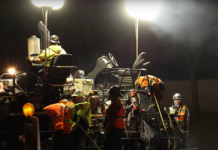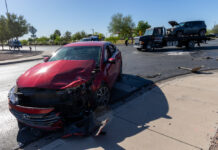For anyone thinking that a meeting at 11 a.m. on a work day may not be well attended, think again.
A standing-room-only crowd packed one of the rooms in the Pinal County Government Campus in Florence Friday morning to hear just where county officials are with proposed changes to zoning ordinances. The zoning ordiances have been in place since 1962.
After receiving a short update on the proposed changes, the crowd had plenty of questions for county officials, lasting past the scheduled 1 p.m. closing of the meeting.
The first in a series of public meetings, the gathering evoked passionate responses from residents of Maricopa, Casa Grande, Florence, Apache Junction and elsewhere. The biggest outcry was against proposed changes to how many large animals people could have on their properties.
Up to now, large animals have been limited to five per acre of land if the noted property is zoned General Rural. Animals falling into this category include cattle, horses, llamas, goats and sheep. A recent proposal would change that limit to only two per acre. The reason behind this thinking is that a greater percentage of Pinal County will become more urban in the years to come.
According to District 3 Pinal County Supervisor David Snider in a recent opinion piece on inmaricopa.com,, none of the new zoning categories are intended to be implemented until the time comes when there is landowner request for a change in a parcel’s zoning.
Thanks to public outcry, Snider said the Planning & Development staff has restored the limits on large animals to the original numbers in all five of the appropriate new zoning areas (RU-2, RU-3.3, RU-5, and RU-10).
District 2 Pinal County Supervisor Sandie Smith told the crowd Friday that public input on the originally proposed changes had been strong.
“The rights you have today do not change,” Smith said. Still, there seemed to be a fair amount of confusion in the room, both with residents and county officials.
Reminding residents that the current zoning language dates back 45 years, Smith said that present classifications do not give officials the tools they need to work with the growth that is currently and will be impacting the county.
The biggest outcry from citizens was the notion that proposed changes to the zoning ordinances is coming from developers who want to build in rural areas of the county. One resident said these proposed changes were a developer mandate aimed at being the first step to regulating the rural lifestyle of county citizens.
“I moved from Scottsdale to Casa Grande to have open roads to enjoy,” one woman said to the crowd. “If developers come in and want high density, you and I will be ousted. With the new changes, won’t that be easier to do?” she asked. One county official said they are looking at how well the new zoning proposals fit in with the existing zoning laws.
One Maricopa resident told those in attendance that these proposed zoning changes do impact people’s lives. “These changes are not desired by the residents,” she told officials. “This is the beginning of opening the door to changing everything that we know. It will be gone. This is not justified to the people who live here.”
As the meeting continued, the cry that developers are the main backers of these proposed changes became louder. While the crowd was mostly hospitable to county officials in attendance, the occasional shout out from the crowd was heard during the Q&A.
“You took out animal restrictions because of public outcry,” one citizen noted. Another citizen said this room is full because everyone is saying don’t do this. “Take animals out of the proposed draft,” they added.
According to Smith, the origin of the proposed zoning changes came from committees that were formed. Smith was responding to one resident who demanded to know who started all these restrictions.
“The committees were formed and they worked on drafts, had different meetings and put this information together, along with a consultant,” Smith said. “This is our first draft.” One resident uttered from the crowd that the consultant likely had ties to developers.
As more than a dozen people took to the microphone during the Q&A, it was clear that no one in the room was happy with what they were hearing.
One resident said she had moved from Tempe to Hidden Valley, after seeing Tempe destroyed by developers. “I moved out there to enjoy the rural life,” she said. “This is not a well-written document. This repeals public participation in the plan.”
Another citizen said the last thing portions of Pinal County needs now is more development. Noting the Maricopa area, the citizen remarked that added developments will have a more negative impact on traffic for one. “We have so many unoccupied homes we can’t sell now,” the citizen said. “So why are we building? “Try to go (drive) through Maricopa in the morning. You can’t do it.”
Saying they wanted Arizona to maintain its open land and rural lifestyle that many in the state have and currently enjoy, one woman had a simple message for officials. “If you want Arizona to be California, keep on going.”
Another public meeting is slated for Oct. 25 at 9 a.m. (runs from 9 a.m. to 8 p.m., with animal discussion from 6 p.m. to 8 p.m.) in the EOC Room at the Pinal County Government Campus, 31 N. Pinal St., Florence.
Photo by Dave Thomas


![Shred-A-Thon to take place tomorrow An image of shredded paper. [Pixabay]](https://www.inmaricopa.com/wp-content/uploads/2024/03/shredded-paper-168650_1280-218x150.jpg)






![Elena Trails releases home renderings An image of one of 56 elevation renderings submitted to Maricopa's planning department for the Elena Trails subdivison. The developer plans to construct 14 different floor plans, with four elevation styles per plan. [City of Maricopa]](https://www.inmaricopa.com/wp-content/uploads/2024/04/city-041724-elena-trails-rendering-218x150.jpg)





![Shred-A-Thon to take place tomorrow An image of shredded paper. [Pixabay]](https://www.inmaricopa.com/wp-content/uploads/2024/03/shredded-paper-168650_1280-100x70.jpg)


